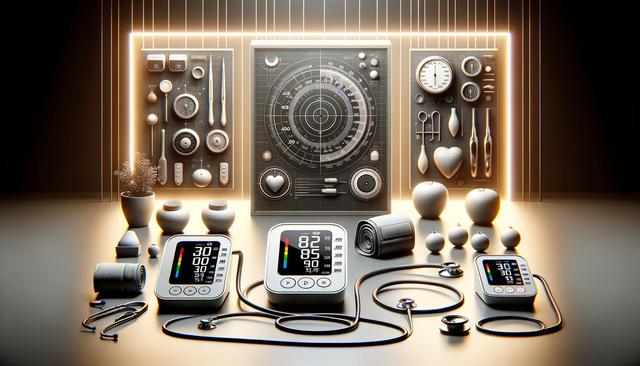Why Home Blood Pressure Monitoring Matters
Monitoring blood pressure at home has become a vital component of managing cardiovascular health. Cardiologists often encourage patients, especially those with hypertension or heart disease, to regularly check their blood pressure outside the clinical setting. Home readings can help identify fluctuations that may not appear during a clinic visit, offering a more comprehensive view of a patient’s condition. This practice is particularly useful for detecting white coat hypertension and masked hypertension, two conditions that can lead to misdiagnosis if only clinical readings are considered.
Using a reliable home blood pressure monitor allows patients to:
- Track their blood pressure trends over time
- Evaluate the effectiveness of medication or lifestyle changes
- Share accurate data with healthcare providers for better treatment decisions
It’s important to note that while home monitoring is beneficial, it doesn’t replace the need for professional medical assessments, especially in cases requiring invasive monitoring techniques for critical care.
Key Features Cardiologists Look for in a Blood Pressure Monitor
When recommending a home blood pressure monitor, cardiologists consider several essential features that contribute to accuracy, ease of use, and long-term reliability. Monitors that are clinically validated for accuracy hold higher credibility among healthcare professionals. These devices undergo rigorous testing to ensure their readings align with standard reference measurements.
Some of the features commonly recommended include:
- Automatic inflation and deflation for user convenience
- Clear, large digital displays for easy readability
- Memory storage with time and date stamps
- Bluetooth or app connectivity for data tracking and sharing
- Adjustable cuffs that fit a wide range of arm sizes
Cuff size and fit are especially critical, as incorrect cuff size can lead to inaccurate readings. Arm monitors are generally preferred over wrist monitors because they tend to provide more consistent results.
Types of Blood Pressure Monitors Available for Home Use
There are several types of blood pressure monitors available for home use, each with its own advantages. Understanding these options can help individuals choose the device that best suits their needs and comfort level. The two main types are upper arm monitors and wrist monitors.
- Upper Arm Monitors: These are the most commonly recommended and are considered more accurate. The cuff wraps around the upper arm and typically provides consistent readings when used correctly.
- Wrist Monitors: These are more compact and convenient for travel but may be less accurate if not positioned correctly at heart level during measurement.
In addition to these, some advanced models offer multi-user functionality, which is ideal for households with more than one individual monitoring their blood pressure. Others include irregular heartbeat detection, providing additional insights into cardiovascular health.
Tips for Accurate Readings at Home
Even the most advanced blood pressure monitor will not provide reliable results if used incorrectly. Cardiologists emphasize the importance of proper technique and conditions when taking a reading. Here are several tips to ensure accuracy:
- Take readings at the same time each day, preferably in the morning and evening
- Sit quietly for at least five minutes before measuring
- Keep your feet flat on the floor and your back supported
- Rest your arm on a flat surface at heart level
- Avoid caffeine, exercise, or smoking at least 30 minutes prior to measuring
Regular calibration and maintenance of the device are also necessary to maintain accuracy. Users should refer to the manufacturer’s guidelines for how often the monitor should be serviced or recalibrated.
Choosing a Device That Fits Your Lifestyle
With many options available on the market, choosing a blood pressure monitor can feel overwhelming. Cardiologists suggest selecting a device that aligns with your lifestyle and comfort level. If you’re someone who travels frequently or prefers a minimalist setup, a compact, portable monitor with Bluetooth capabilities may suit your needs. On the other hand, individuals managing chronic conditions may benefit from a model with detailed tracking, frequent calibration reminders, and the ability to store multiple readings.
Consider these factors when choosing a device:
- How frequently you plan to measure your blood pressure
- Whether multiple users will be sharing the device
- Your comfort with using digital apps or syncing data
- Any physical limitations that might make cuff placement difficult
Ultimately, the most appropriate monitor is one that you’ll use consistently and correctly. Consulting with your healthcare provider can help narrow down choices based on your specific health needs.
Conclusion: Making Informed Choices for Better Heart Health
Investing in a high-quality home blood pressure monitor is a practical step toward managing your cardiovascular health proactively. By understanding the types of monitors available, the essential features to look for, and the proper techniques for use, individuals can contribute meaningfully to their own care. Cardiologists emphasize consistency, accuracy, and communication with healthcare providers as key elements of effective blood pressure management at home. With the right device and informed habits, monitoring blood pressure becomes a valuable and empowering routine in maintaining long-term heart health.


